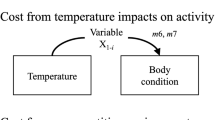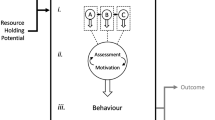Abstract
The understanding of trade-offs between behaviours is fundamental to the study of animal behaviour. Individuals may often be faced with the choice of which of two mutually incompatible behaviours to perform. Here, I present a model investigating the trade-off between two behaviours, where one of the behaviours is crucial to the success of the other. I illustrate the results with examples, considering particularly a trade-off between territorial defence and courtship. I investigate how the ability of an individual to perform the behaviours changes the time or energy allocated to each behaviour. Intuition suggests that the time invested in performing a behaviour should decline as the individual’s ability to perform the behaviour increases. Explicit, quantitative modelling suggests that this is not always the case. Instead, we see a pattern where investment in one of the behaviours at first increases and then decreases as the ability to perform the behaviour increases. This finding has implications for the empirical study of trade-offs between behaviours, since it could appear that individual ability has no effect on the trade-off under consideration. I discuss potential methods for distinguishing whether time allocation changes in a counter-intuitive, non-monotonic way with increasing individual ability, or whether there is indeed no effect.


Similar content being viewed by others
References
Adams ES (2001) Approaches to the study of territory size and shape. Annu Rev Ecol Sys 32:277–303
Alatalo RV, Lundberg A, Glynn C (1986) Female pied flycatchers choose territory quality and not male characteristics. Nature 323:152–153
Alatalo RV, Carlson A, Lundberg A. (1988) The search cost in mate choice of the pied flycatcher. Anim Behav 36:289–291
Badyaev AV, Ghalambar CK (2001) Evolution of life histories along elevational gradients: trade-off between parental care and fecundity. Ecology 82:2948–2960
Beaugrand JP, Payette D, Goulet C (1996) Conflict outcome in male green swordtail fish dyads (Xiphophorus helleri): interaction of body size, prior dominance/subordination experience, and prior residency. Behaviour 133:303–319
Berglund A (1993) Risky sex: male pipefishes mate at random in the presence of a predator. Anim Behav 46:169–175
Borgia G (1979) Sexual selection and the evolution of mating systems. In: Blum MS, Blum NA (eds) Sexual selection and reproductive competition in insects. Academic Press, New York, pp 19–80
Brown C, Laland KN (2003) Social learning in fishes: a review. Fish Fish 4:280–288
Candolin U (1997) Predation risk affects courtship and attractiveness of competing threespine stickleback males. Behav Ecol Sociobiol 41:81–87
Candolin U (2003) The use of multiple cues in mate choice. Biol Rev 78:575–595
Candolin U, Voigt HR (1998) Predator-induced nest site preference: safe nests allow courtship in sticklebacks. Anim Behav 56:1205–1211
Crowley PH, Travers SE, Linton MC, Cohn SL, Sih A, Sargent RC (1991) Mate density, predation risk, and the seasonal sequence of mate choices—a dynamic game. Am Nat 137:567–596
Daly M (1978) The cost of mating. Am Nat 112:711–774
Dunn PO, Robertson RJ, Michaud-Freeman D, Boag PT (1994) Extra-pair paternity in tree swallows: why do females mate with more than one male? Behav Ecol Sociobiol 35:273–281
Endler JA (1987) Predation, light intensity and courtship behaviour in Poecilia reticulata (Pisces: Poeciliidae). Anim Behav 35:1379–1385
Enquist M, Leimar O (1983) Evolution of fighting behaviour, decision rules and assessment of relative strength. J Theor Biol 102:387–410
Fuller R, Berglund A (1996) Behavioral responses of a sex-role reversed pipefish to a gradient of perceived predation risk. Behav Ecol 7:69–75
Godin J-GJ (1995) Predation risk and alternative mating tactics in male Trinidadian guppies (Poecilia reticulata). Oecologia 103:224–229
Godin J-GJ, Briggs SE (1996) Female mate choice under predation risk in the guppy. Anim Behav 51:117–130
Gronstol GB (1996) Aerobatic components in the song-flight display of male lapwings Vanellus vanellus as cues in female choice. Ardea 84:45–55
Hack MA (1997) The energetic costs of fighting in the house cricket, Acheta domesticus L. Behav Ecol 8:28–36
Hedrick AV, Dill LM (1993) Mate choice by female crickets is influenced by predation risk. Anim Behav 46:193–196
Heg D, Ens BJ, Van der Jeugd HP, Bruinzeel LW (2000) Local dominance and territorial settlement of nonbreeding oystercatchers. Behaviour 137:473–530
Hixon MA (1980) Food production and competitor density as determinants of feeding territory size. Am Nat 115:510–530
Houston AI, McNamara JM, Hernandez ML (2003) How does an individual’s optimal behaviour depend on its quality? An analysis based on relative ability. Evol Ecol Res 5:195–212.
Howard RD (1978) The evolution of mating strategies in bullfrogs, Rana catesbeiana. Evolution 32:850–871
Hsu YY, Wolf LL (1999) The winner and loser effect: integrating multiple experiences. Anim Behav 57:903–910
Humphries S, Ruxton GD, Metcalfe NB (1999) Patch choice and risk: relative competitive ability is context dependent. Anim Behav 58:1131–1138
Itzkowitz M, Haley M (1999) Are males with more attractive resources more selective in their mate preferences? A test in a polygynous species. Behav Ecol 10:366–371
Jennions MD, Backwell PRY (1996) Residency and size affect fight duration and outcome in the fiddler crab Uca annulipes. Biol J Linn Soc. 57:293–306
Jennions MD, Petrie M (1997) Variation in mate choice and mating preferences: a review of causes and consequences. Biol Rev 72:283–327
Johnsson JI, Noebbelin F, Bohlin T (1999) Territorial competition among wild brown trout fry: effects of ownership and body size. J Fish Biol 54:469–472
Koga T, Backwell PRY, Jennions MD, Christy JH (1998) Elevated predation risk changes mating behaviour and courtship in a fiddler crab. Proc R Soc Lond B 265:1385–1390
Kolok AS (1999) Interindividual variation in the prolonged locomotor performance of ectothermic vertebrates: a comparison of fish and herpetofauna methodologies and a brief review of the recent fish literature. Can J Fish Aquat Sci 56:700–710
Maynard Smith J, Parker GA (1976) The logic of asymmetric contests. Anim Behav 24:159–175
Morrell LJ, Kokko H (2004) Can too strong female choice deteriorate male ornamentation? Proc R Soc Lond B 271:1597–1604
Petersen G, Hardy ICW (1996) The importance of being larger: parasitoid intruder-owner contests and their implications for clutch size. Anim Behav 51:1363–1373
Plaut I (2001) Critical swimming speed: its ecological relevance. Comp Biochem Phys A 131:41–50
Pruett-Jones S (1992) Independent versus non-independent mate choice—do females copy each other? Am Nat 140:1000–1009
Qvarnström A, Forsgren E (1998) Should females prefer dominant males? Trends Ecol Evol 13:498–501
Real LA (1991) Search theory and mate choice. 2. Mutual interaction, assortative mating, and equilibrium variation in male and female fitness. Am Nat 138:901–917
Reiss MJ (1989) The allometry of growth and reproduction. Cambridge University Press, Cambridge
Reynolds JD (1993) Should attractive males court more—theory and a test. Am Nat 141:914–927.
Reynolds JD, Gross MR (1990) Costs and benefits of female mate choice—is there a lek paradox? Am Nat 136:230–243.
Roff DA (1992) The evolution of life histories: theory and analysis. Chapman and Hall, New York
Santangelo N, Itzkowitz M, Richter M, Haley MP (2002) Resource attractiveness of the male beaugregory damselfish and his decision to court or defend. Behav Ecol 13:676–681
Schoener TW (1983) Simple models of optimal feeding-territory size: a reconciliation. Am Nat 121:608–629
Sevenster P (1961) A causal study of displacement activity. Fanning in Gasterosteus aculeatus L. Behav Suppl 9:1-170
Sih A, Krupa J, Travers SE (1990) An experimental study on the effects of predation risk and feeding regime on the mating behaviour of the water strider. Am Nat 135:284–290
Taylor PW, Elwood RW (2003) The mismeasure of animal contests. Anim Behav 65:1195–1202
Trivers RL (1976) Sexual selection and resource-accruing abilities in Anolis garmani. Evolution 30:253–269
Turner AM, McCarty JP (1998) Resource availaility, breeding site selection and reproductive success of red-winged blackbirds. Oecologia 113:140–146
Uy JAC, Patricelli GL, Borgia G (2001) Complex mate searching in the satin bowerbird Ptilonorhynchus violaceus. Am Nat 158:530–542
Whittingham LA, Robertson RJ (1994) Food availability, parental care and male mating success in red-winged blackbirds (Agelaius phoeniceus). J Anim Ecol 63:139–150
Wilz KJ (1972) Causal relationships between aggression and the sexual and nest behaviours in the three-spined stickleback (Gasterosteus aculeatus). Anim Behav 20:335–340
Worley AC, Houle D, Barrett SCH (2003) Consequences of hierarchical allocation for the evolution of life-history traits. Am Nat 161:153–167
Acknowledgements
I would like to thank Andrew Jackson, Hanna Kokko, Neil Metcalfe, Graeme Ruxton, Colette St. Mary and three anonymous referees for useful comments on this and previous versions of the manuscript, and the Aquatic Discussion Group at the University of Glasgow for useful discussions. Funding was provided by a Natural Environment Research Council research studentship (NER/S/A/2001/06190).
Author information
Authors and Affiliations
Corresponding author
Additional information
Communicated by C. St. Mary
Rights and permissions
About this article
Cite this article
Morrell, L.J. Are behavioural trade-offs all they seem? Counter-intuitive resolution of the conflict between two behaviours. Behav Ecol Sociobiol 56, 539–545 (2004). https://doi.org/10.1007/s00265-004-0821-6
Received:
Revised:
Accepted:
Published:
Issue Date:
DOI: https://doi.org/10.1007/s00265-004-0821-6




